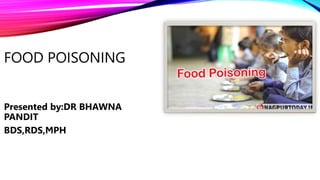
Food poisoning [presented BY;DR BHAWNA PANDIT].pptx
- 1. FOOD POISONING Presented by:DR BHAWNA PANDIT BDS,RDS,MPH
- 2. FOOD POISONING • Food poisoning is an illness that occurs after eating or drinking anything that is contamination. • according to WHO: • Foodborne illnesses are usually infectious or toxic in nature and caused by bacteria, viruses, parasites or chemical substances entering the body through contaminated food.
- 3. SYMPTOMS • Symptoms vary depending on what is causing the illness. They may begin within a few hours or a few weeks depending on the cause. • Common symptoms are: • Upset stomach. • Vomiting. • Diarrhea. • Diarrhea with bloody stools. • Stomach pain and cramps. • Fever. • Headache.
- 4. CAUSES OF FOOD POISONING 1) Infectious agents include; a)Bacteria;Salmonella,v.cholera,E.coli,Botulism. b)Parasite:trichinella spiralis. c)Protozoan:Entamoeba histolytica,giardia lambli. d)Virus:Rotavirus,Hepatitis A Virus. 2) Other toxic agents,which includes a)Chemicals,pesticides,Heavy metals,gasoline. b)Plants:Mushrooms c)Others:Puffer fish
- 5. CONT: • 3) Poor sanitation and preparation. • 4) Improper packing and storage
- 7. SOURCE • Some foods are more likely than others to contain germs that can make you sick. These foods include: Raw and undercooked foods from animals, including meat, chicken and other poultry, eggs, raw (unpasteurized) milk and products made from it, and seafood. • INCUBATION PERIOD • The incubation period is usually 24 to 48 hours. • Recovery is normally within 48 hours, after which a person may still be a little weak for a day or so.
- 8. Etiologic Agent Incubation Period Salmonella Typhi 3-60 days; usually 7-14 days Shigella spp. 12 hrs-6 days; usually 2-4 days Staphylococcus aureus 30 min-8 hrs; usually 2-4 hrs Streptococcus, group A 1-4 days
- 9. HOW TO PREVENT FOOD POISONING
- 10. • Clean: Wash your hands and surfaces often. • Wash your utensils, cutting boards, and countertops with hot, soapy water after preparing each food item. • Rinse fresh fruits and vegetables under running water. • Separate: Don’t cross-contaminate. • Raw meat, chicken and other poultry, seafood, and eggs can spread germs to ready-to-eat food unless you keep them separate.
- 11. • Cook to the right temperature • Food is safely cooked when the internal temperature gets high enough to kill germs that can make you sick. The only way to tell if if food is safely cooked is to use a food thermometer. You can’t tell tell if food is safely cooked by checking its color and texture (except for seafood). • Chill: Refrigerate promptly. • Bacteria can multiply rapidly if left at room temperature or in the “Danger Zone” between 40°F and 140°F. Never leave perishable food out for more than 2 hours (or 1 hour if exposed to temperatures above 90°F).
- 12. THE ROLE OF GOVERNMENT TO PREVENT FOOD POISONING • The government plays a crucial role in preventing food poisoning . • They are; • Regulation and Oversight: Government agencies, such as the Food and Drug Administration (FDA) or the Food Standards Agency (FSA) establish and enforce regulations and standards for food safety. • Inspection and Monitoring: Government inspectors regularly inspect food establishments, including restaurants, processing plants, and farms, to ensure that they are following proper food safety practices.
- 13. • Food Safety Education: Governments often provide educational programs and resources to both food businesses and the public. This includes information on safe food handling, cooking temperatures, and the risks associated with certain foods. This helps raise awareness and promote safe practices. • Research and Risk Assessment: Government agencies conduct research to better understand foodborne illnesses, their causes, and trends. This research informs the development of food safety policies and regulations.
- 14. • Enforcement of Food Safety Laws: Governments have the authority to enforce food safety laws and regulations. They can impose fines, penalties, and even shut down facilities that consistently fail to meet safety standards. • Emergency Response: In the event of a foodborne illness outbreak or a significant food safety incident, the government plays a critical role in coordinating the response. This may involve investigations, containment measures, and public communication.
- 15. THANKYOU